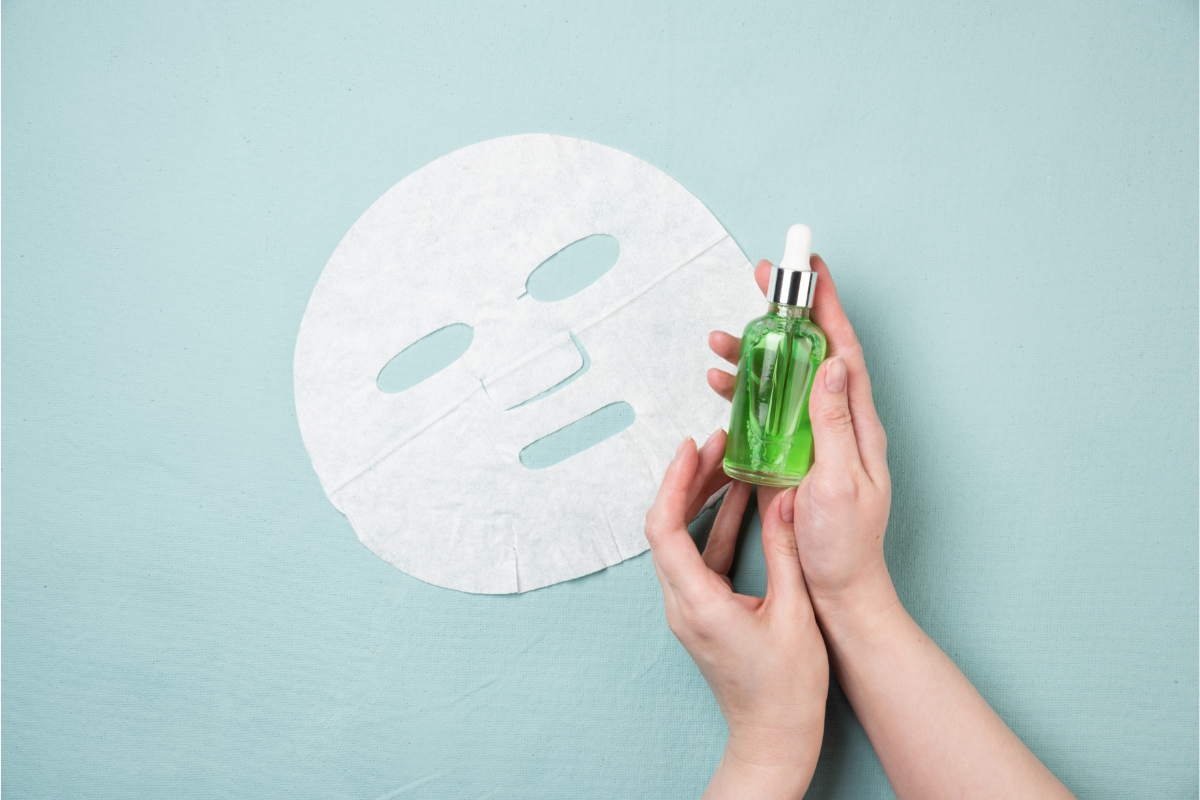Seborrhoeic dermatitis is a common skin condition. It is characterised by redness, itching and flaking of the skin. It is often associated with conditions such as rosacea and SIBO. Fortunately, there are natural ways to relieve the symptoms of seborrhoeic dermatitis and strengthen the hydrolipidic film to improve overall skin health.
What causes seborrhoeic dermatitis?
One of the main causes of seborrhoeic dermatitis is an imbalance in the skin’s microbiota. The microbiota is the set of micro-organisms that live on and in our bodies. It plays a crucial role in skin health. In fact, it maintains the balance of beneficial bacteria and protects against pathogens. Research shows that people with DS tend to have an unbalanced skin microbiota . This translates into an overabundance of pathogenic bacteria and an under-representation of beneficial bacteria. In fact, if you’re wondering whether probiotics have anything to do with skin health, go and read our article on the subject!
Symptoms and diagnosis of seborrhoeic dermatitis
Seborrhoeic dermatitis manifests itself through several distinct signs. You may notice red patches, particularly on the scalp, face and other areas rich in sebaceous glands. These patches are often accompanied by itching and flaking, similar to dandruff. It is common to feel some irritation, especially in the affected areas.
How do I know if I have seborrhoeic dermatitis?
To confirm seborrhoeic dermatitis, a doctor will first examine your skin. He or she will look for signs such as redness, the location of patches and the presence of scaling. Sometimes, a biopsy or skin tests may be necessary to rule out other conditions. Diagnosis is based on observing the characteristic symptoms and, in some cases, ruling out similar diseases. Your doctor may also ask you about your medical history and lifestyle habits, to better understand the factors that may be influencing your condition.
Psychological and social impact
Beyond its physical symptoms, seborrhoeic dermatitis can have a profound emotional impact. Sufferers often feel anxious and embarrassed about the appearance of their skin, which can lead to a drop in self-esteem. It is common to feel isolated or misunderstood, especially during severe outbreaks. These feelings can sometimes lead to depression, underlining the importance of comprehensive care.
Social and professional support
To cope with these challenges, social and professional support is essential. It is beneficial to talk about your difficulties with friends, family members or support groups. These exchanges can offer comfort and strategies for managing the psychosocial aspects of the disease. In addition, consulting a psychologist or mental health professional can help develop effective coping mechanisms. Their expertise can help you deal with the emotional consequences of seborrhoeic dermatitis and strengthen your mental and social well-being.
How can I manage seborrhoeic dermatitis?
To restore the balance of the skin microbiota, it is important to take steps to strengthen the skin barrier. The skin barrier is the skin’s protective layer. It retains moisture and prevents bacteria and irritants from entering. Essential fatty acids, such as those found in vegetable oils, are particularly important for strengthening the skin barrier. In fact, they nourish and repair the skin’s cell membranes. This makes them more resistant to irritants and bacteria.
As well as fatty acids, other nutrients and natural ingredients can help relieve the symptoms of DS.Glycolic acid, for example, is an alpha hydroxy acid (AHA ) that can help exfoliate the skin and reduce flaking. Vitamin C is an antioxidant that can help reduce inflammation and protect against free radical damage.
The importance of a healthy lifestyle
It’s important to work on your overall health to get the best results. This can include lifestyle changes such as improving your diet, reducing stress and exercising, as well as therapeutic interventions such as topical treatments, immune-boosting supplements and alternative therapies to manage stress. We advise you to consult a healthcare professional to assess other risk factors. Hormonal and dietary disorders can lead to imbalances that can contribute to DS. In short, to achieve good results, you need to work on your overall health and follow a personalised treatment plan.
What are the recognised treatments for managing this skin condition?
Managing seborrhoeic dermatitis involves a number of conventional medical treatments. These treatments vary according to the severity and location of the disease.
Prescription medicines
For more severe cases or those that do not respond to other treatments, doctors may prescribe antifungal medication in pill form. There are also creams or ointments containing calcineurin inhibitors, such as tacrolimus (Protopic) or pimecrolimus (Elidel), which can be effective. However, these treatments are not always the first choice due to concerns about a potential risk of cancer and their higher cost compared with mild corticosteroids.
Topical treatments
Shampoos play a key role in scalp treatment. They are classified according to their active ingredient, which may include zinc pyrithione, selenium sulphide, 1% ketoconazole, tar orsalicylic acid. The frequency of use of these shampoos varies according to the severity of symptoms and the individual’s hair care practices. For areas other than the scalp, medicated creams may be used. It is advisable to try a mild corticosteroid cream first, and if that doesn’t work, an antifungal such as ketoconazole can be tried.
What active ingredients are effective for treating DS?
Topical treatments for seborrhoeic dermatitis include creams, lotions and gels containing ingredients such as vitamin D, corticosteroids, ketoconazole, salicylic acid and azelaic acid, which can relieve inflammation and itching of the skin.
It is important to note that the side effects associated with topical corticosteroids can be mitigated by intermittent use or steroid-sparing preparations, such as topical tacrolimus 1%. For the treatment of generalised or refractory forms of the disease, oral therapies may be considered, such as ketoconazole, itraconazole and fluconazole, although liver function monitoring is required for some of these drugs.
The latest research on the treatment of seborrhoeic dermatitis
Recent research into seborrhoeic dermatitis has highlighted a number of innovative treatments. Topical treatments remain central, with the use of antifungal and anti-inflammatory agents to control Malassezia proliferation and inflammation. Alternative therapies, such as tea tree oil, Quassia amara and Solanum chrysotrichum, are also being studied.
Emerging treatments
The focus is on developing new approaches, including systemic treatments for widespread or resistant cases. There is growing interest in solutions such as probiotics to modulate the mycobiome and skin microbiome, offering promising prospects for future treatments. These advances reflect a better understanding of the disease and pave the way for more targeted and effective treatments.
Are probiotics effective in managing seborrhoeic dermatitis?
Scientific studies have shown that food supplements containing probiotics can be effective in managing seborrhoeic dermatitis. Probiotics are beneficial bacteria that live in the intestine. They play a crucial role in skin health . Research shows that people with seborrhoeic dermatitis tend to have an imbalanced skin microbiota, with an overabundance of pathogenic bacteria and an under-representation of beneficial bacteria. To restore this balance, probiotics can be used to increase the beneficial populations and reduce the pathogens. This can help relieve symptoms such as redness, itching and flaking.
How can I avoid developing seborrhoeic dermatitis?
To prevent seborrhoeic dermatitis, adopt an appropriate skin care routine. Use gentle, non-irritating products and moisturise your skin regularly. Avoid harsh shampoos and soaps, which can destabilise your skin’s natural balance. It’s also advisable to limit foods rich in fat and sugar, as they can influence sebum production. What’s more, stress plays a role in this condition, so practising relaxing activities such as yoga or meditation can be beneficial.
The importance of prevention
Preventing seborrhoeic dermatitis is crucial to avoiding flare-ups and maintaining a good quality of life. By taking care of your skin and managing risk factors, you can significantly reduce the frequency and intensity of symptoms. Good prevention helps keep your skin healthy, minimises discomfort and enables you to manage the condition better in the long term.
Comparison with other skin diseases
Seborrhoeic dermatitis, although unique, shares similarities with other skin conditions, which sometimes makes diagnosis difficult.
Differences and similarities
One condition often confused with seborrhoeic dermatitis is psoriasis. Whereas seborrhoeic dermatitis generally manifests itself as red patches and oily scaling, particularly on the scalp and face, psoriasis is characterised by thicker patches and silvery scaling. In addition, psoriasis often affects other areas such as the elbows and knees, and may involve changes in the nails.
Eczema is another condition with which seborrhoeic dermatitis is sometimes confused. Eczema causes intense itching and rashes, but tends to appear on the folds of the elbows and knees, which distinguishes it from seborrhoeic dermatitis.
The importance of accurate diagnosis
Accurate diagnosis is crucial because the treatment for these different conditions varies considerably. For example, treatments for psoriasis can be more intense and targeted, while eczema often requires intensive moisturising and itch management. Misdiagnosis can lead to inappropriate treatment and worsening of symptoms.
It is therefore essential to consult a dermatologist for an accurate diagnosis. The specialist will carry out a thorough examination and, if necessary, additional tests to differentiate seborrhoeic dermatitis from other skin conditions. An accurate diagnosis is the key to effective treatment and a better quality of life for those affected by these skin disorders.
Is seborrhoeic dermatitis contagious?
Seborrhoeic dermatitis (SD) is not a contagious disease. According to current medical knowledge, it results from an inflammatory reaction of the skin to certain factors such as the presence of a yeast called Malassezia, hormonal changes, stress and genetic factors. This yeast occurs naturally on the skin of most people without causing any problems, but in some individuals it can trigger an inflammatory reaction leading to DS.
Unlike some skin conditions caused by viruses or bacteria, DS is not transmitted by physical contact or other means of interpersonal transmission. It is linked to the skin’s individual reactivity and the balance of its microbiome, which is unique to each person.
It is important to note that although DS is not contagious, it can sometimes be difficult to manage and may require treatment to control symptoms. People with DS should consult a dermatologist for an accurate diagnosis and a suitable treatment plan.
Read more:
- https://www.ncbi.nlm.nih.gov/books/NBK551707/
- https://www.ncbi.nlm.nih.gov/pmc/articles/PMC9365318/
- https://pubmed.ncbi.nlm.nih.gov/21760742/
- J Dermatolog Treat. 2019 Mar;30(2):158-169. doi: 10.1080/09546634.2018.1473554. Epub 2018 May 24.
Treatment of seborrheic dermatitis: a comprehensive review







